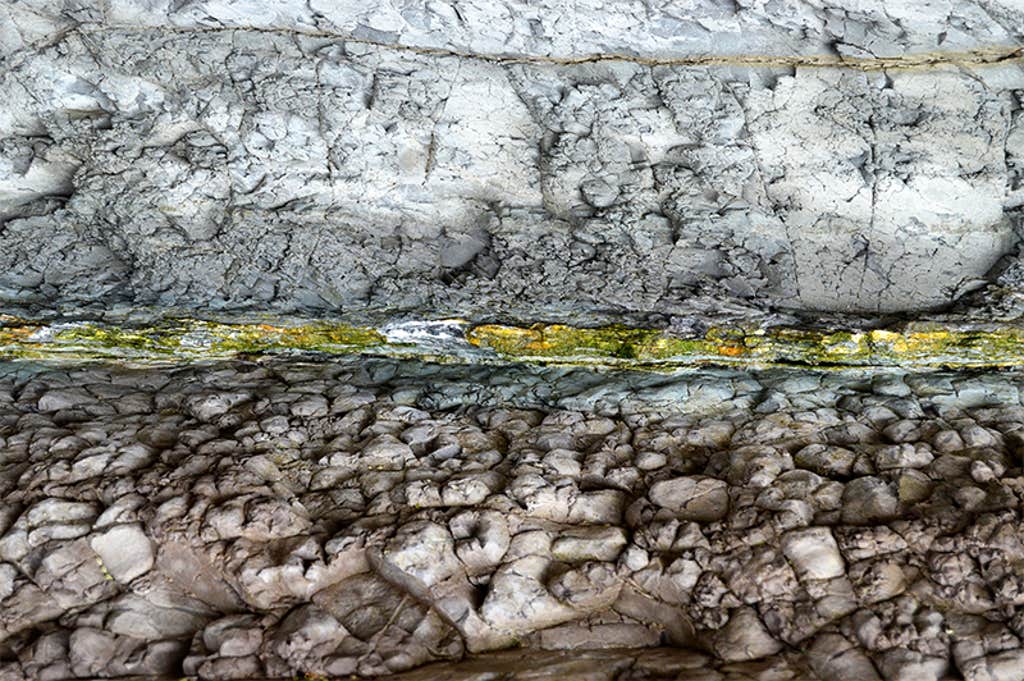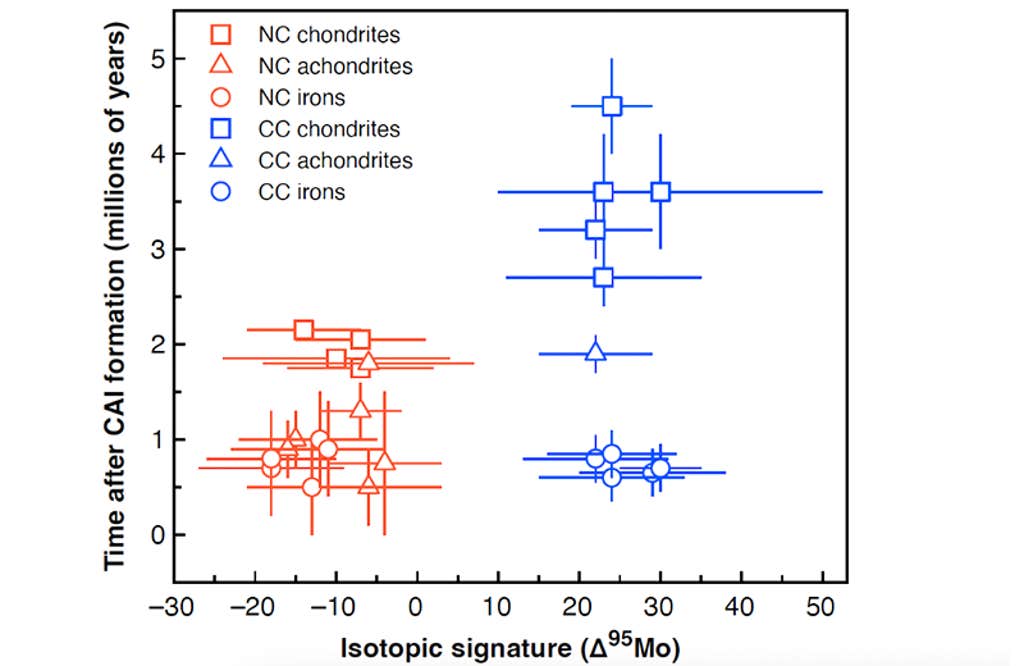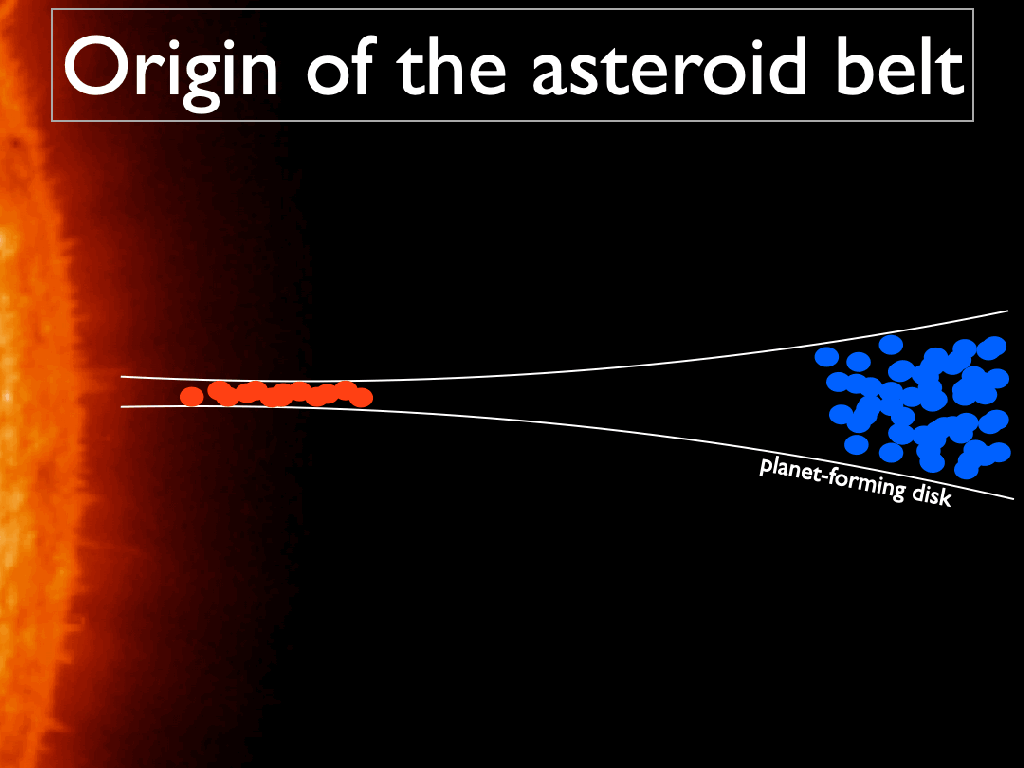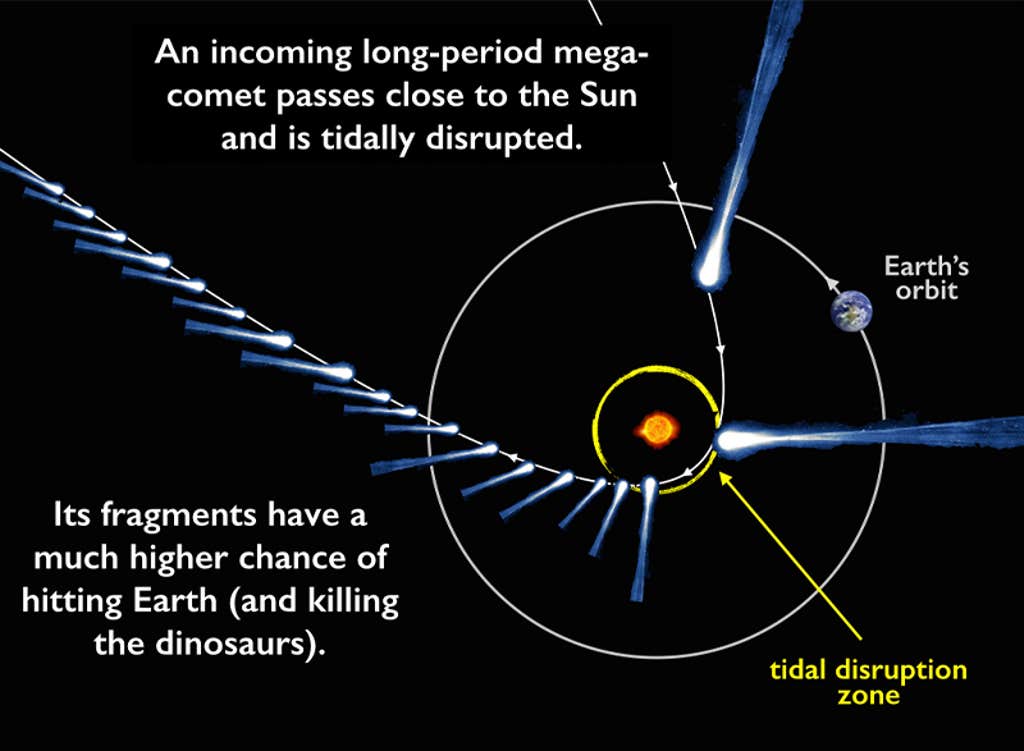The end of the story is written, literally, in stone. Before a rock from space smashed into Earth and wiped out much of life some 66 million years ago, the rock had a long story of its own—one scientists have known surprisingly little about. Where exactly did it come from, and what does it mean for future impacts that might pose a threat to humanity?
For decades, the prevailing idea has been that the impactor was an asteroid rather than a comet or something else—although a few scientists in the past argued for alternate interpretations for the non-avian dinosaurs’ demise related to widespread volcanism or sea-level regression. A newly published analysis supports the theory that the doom-bringing rock was indeed an asteroid. It also clarifies its origin story: It was likely born far out in the early solar system, beyond Jupiter’s orbit, before it plunged closer to the sun, eventually crashing down and ruining the dinosaurs’ party. The researchers, led by cosmochemist Mario Fischer-Gödde, at the University of Cologne, published their measurements recently in Science.
The evidence for the impact, of course, is spread across the globe, in thin layers below our feet. Decades of geological measurements have found that this geologic boundary, the Cretaceous-Paleogene (K-Pg), is more enriched in rare elements, such as iridium, compared with neighboring layers of rock. Guess what else contains a lot of iridium? Meteorites, the fragments of asteroids that have fallen to Earth.

But asteroid or comet, why does it matter? Asteroids are mostly rocky and tend to live in the inner solar system, with the vast majority confined to a belt between the orbits of Mars and Jupiter. This is a large swath of solar system real estate, and we have mapped out the orbits of more than 1 million asteroids. The inner portion of this asteroid belt is dominated by dry, rocky objects that are the parent bodies of ordinary meteorites (“ordinary” because they are the most common type). In contrast, the outer part of the asteroid belt between Mars and Jupiter contains darker, carbon- and water-rich rocky objects, which represent the parent bodies of carbonaceous meteorites (“carbonaceous” because they are carbon-rich, although they come in many different flavors).
Comets, on the other hand, are ice-rich and spend their time much farther from the sun, in the Kuiper belt, a scattered disk located beyond Neptune, or in the Oort cloud, which resides at the boundary of the solar system and stretches several light-years away.
Geological measurements offer the best clues to the nature of the dino-killer. Like iridium, chromium is a metal that is concentrated in the K-Pg boundary layer. Researchers measuring chromium isotopes back in 1998 found signatures that were consistent with carbonaceous meteorites, a strong hint that the impactor was a carbonaceous asteroid. But there is enough chromium native to Earth’s crust that there’s a reasonable chance it contaminated the samples from Chicxulub, Mexico, the dinosaur-killer’s impact site.
We have mapped out the orbits of more than 1 million asteroids.
More recently, a 2016 study by geochemist Steven Goderis and colleagues used drill cores extending underneath the crater to map out the sequence of events that followed the impact in unprecedented detail. Their conclusion was consistent with the chromium measurements, and supports the idea that the impactor was a carbonaceous asteroid.
In 2021, a study by astrophysicist Amir Siraj and theoretical physicist Avi Loeb (of ‘Oumuamua was an alien artifact fame) claimed that the K-Pg impactor came from a comet, not an asteroid. Among long-period comets that pass within Earth’s orbit, about 20 percent pass so close to the sun that they are torn apart. This process creates strands of comet fragments that increase the odds of collision with Earth. However, several planetary scientists—notably, astrophysicist Steve Desch and colleagues in their rebuttal paper—disputed the cometary claim, pointing out that this sort of disruption usually only produces about 20 fragments, rather than the 600-plus needed for comets to become a more likely impact source than asteroids.

In their recent study, Fischer-Gödde and colleagues provide a fresh perspective on the nature of the devastating space rock, using measurements of ruthenium isotopes in the rocks below modern-day Chicxulub. Unlike chromium, ruthenium is much more abundant in meteorites than in Earth’s crust, making it more representative of material from the impactor. Their results matched the chromium results, demonstrating that the impactor was almost certainly an asteroid and a carbonaceous one at that. They were able to provide even finer detail, showing that it could belong to a few different subtypes of carbonaceous meteorites, but was not consistent with the CI subgroup, a particular class of meteorites that is extremely rich in water and other volatile compounds that only condense at very low temperatures.
This brings us closer to uncovering where this ill-fated rock was born. Thanks to isotopic measurements like those of Fischer-Gödde and colleagues, recent models of solar system evolution have re-written the asteroid belt’s story. The two main classes of meteorites—ordinary and carbonaceous—have distinct chemical fingerprints, as measured in a number of different elements.
Planetary scientists think that some—and maybe all—asteroids are immigrants. They were likely born in a different part of the solar system, and later implanted into the belt. We think this happened in two phases. First, when the gas giant planets Jupiter and Saturn formed, their gravitational forces scattered objects in all directions. A lot of those objects were lost from the solar system entirely; many others probably collided with the growing rocky planets (delivering water). But some were trapped in the asteroid belt, preferentially in the outer parts. Those were the carbonaceous asteroids. Later, when the rocky planets were in the last phases of their growth, they scattered some objects outward, and some were trapped in the asteroid belt, preferentially in the inner parts. Those were the “ordinary” asteroids.

Measurements of an asteroid called Ryugu, brought back with the Hayabusa-2 spacecraft in 2022, have suggested that the CI subclass probably originated the farthest from the sun of all the carbonaceous meteorites. CIs are therefore the best match to comets. However, Fischer-Gödde and colleagues found that CIs do not match the Chicxulub impactor. This is the nail in the coffin of Siraj and Loeb’s dino-killing comet theory.
If most of our meteorites are “ordinary” and came from the inner asteroid belt, it might seem strange that the asteroid that landed off the coast of the Yucatan came from the outer belt. A 2021 study by astronomer David Nesvorny and colleagues show that this is actually not all that surprising.
It comes down to exactly how objects make their way from the asteroid belt down to Earth. This happens in two steps.
First, they are pushed by thermal effects with the sun: Asteroids are heated by the sun (absorbing momentum from that sunlight) and then, as they spin, they re-radiate their heat in a different direction. Depending on their exact spin configuration, asteroids very slowly (over billions of years) drift inward or outward, with smaller asteroids drifting much faster than larger ones. Second, some asteroids are pushed into regions of the belt that are not stable, which act as a conveyor belt toward the rocky planets.
Recent models of solar system evolution have re-written the asteroid belt’s story.
These unstable resonances, as they are called, correspond to spots where an asteroid’s orbital movement lines up with the orbit of Saturn or Jupiter. When a pair of neighboring bodies are in orbital resonance, the two objects keep re-aligning after a certain number of orbits.
For example, one type of resonance occurs when an asteroid’s orbital period forms a simple ratio with Jupiter’s—for example, in the “3:1 resonance” in the center of the belt, an asteroid’s orbit is exactly three times longer than Jupiter’s. The inner edge of the asteroid belt is set by a very strong resonance with Saturn.
Nesvorny and colleagues showed that asteroids smaller than 1 kilometer in diameter are likely to collide with Earth after drifting into a single strong resonance located in the inner asteroid belt. However, larger asteroids like the K-Pg impactor are more likely to collide with Earth after shuffling between a series of resonances across the belt, before ending up among the rocky planets. Collisions from larger asteroids are therefore more likely to come from across the asteroid belt, whereas smaller asteroid impacts usually originate in the inner belt.

Given its carbonaceous (but not CI) nature, we can now tell the full story of the K-Pg impactor’s life. It was born in the middle parts of the sun’s gaseous planet-forming disk, in a region that was cold enough to incorporate some ice and carbon-rich organic molecules. It drifted gently inward in the disk, until Jupiter and Saturn entered a rapid phase of growth (a few million years after the start of solar system formation) that shook the foundations of its neighborhood.
Our protagonist’s path around the sun was abruptly changed, and it underwent a dramatic close encounter with Saturn and then Jupiter, before being flung far closer to the young sun than ever before. Feeling a massive headwind as it plowed through warmer gas, the object’s trajectory slowly shifted until it was trapped onto a stable orbit in the outer parts of the asteroid belt, leaving it as a run-of-the-mill carbonaceous asteroid.
For the next 4 billion years, its orbit was steady and unremarkable. It felt a gentle nudge from the sun’s energy bouncing unevenly off its surface, but paid little mind. Eventually, however, it ended up in the wrong spot: an unstable resonance. Its orbit deviated due to slow gravitational kicks from the giant planets, and the object ended up even closer to the sun, entering the realm of the terrestrial planets. After a series of close encounters (likely with Mars and Earth), the object’s ultimate trajectory aligned directly with Earth. About 66 million years ago, it met its own demise, alongside much of our planet’s life at the time.
So, when do we expect the next big asteroid to collide with Earth?
According to Nesvorny and his colleagues, there are about two impacts from asteroids large enough to kill the dinosaurs every billion years. There is a global-scale catastrophic impact with a somewhat smaller (5 kilometer-diameter) asteroid every 30 to 60 million years.
That’s a big enough threat that, in 1992, a Congressional study led to the “Spaceguard goal,” a NASA mandate to find more than 90 percent of near-Earth asteroids larger than 1 kilometer within 10 years. (The term Spaceguard was coined by Arthur C. Clarke in his 1973 novel, Rendezvous with Rama, in which the Spaceguard system gave advance warning for objects with the potential to hit Earth, put in place after an asteroid impact.) The census of objects that could potentially cause global devastation is far from complete and is the basis of one key project of the upcoming Vera C. Rubin telescope’s Legacy Survey of Space and Time.
So, while most dinosaurs were wiped out by a dark rock propelled over billions of years onto an ill-fated collision course, we humans at least have the hope of spotting the next big one soon enough to write a different story for ourselves, if we choose to. ![]()
Lead image: Naeblys / Shutterstock
































